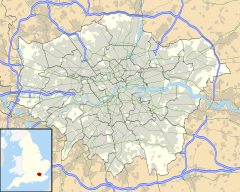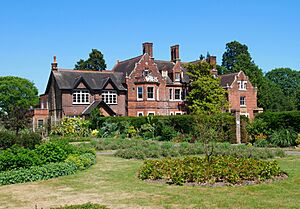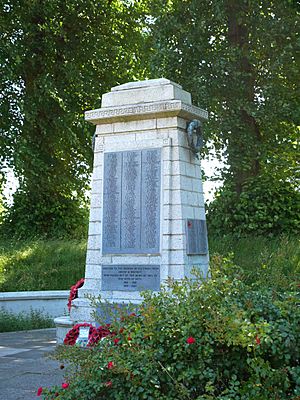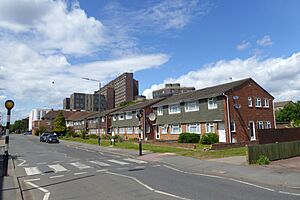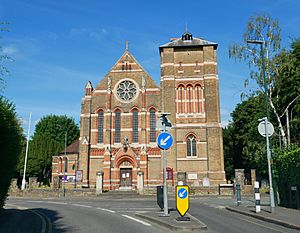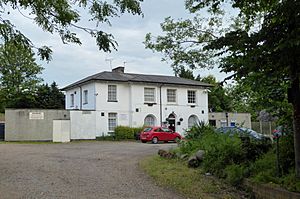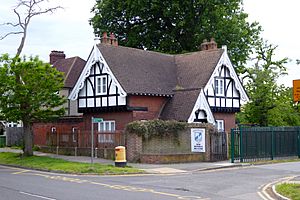Sidcup facts for kids
Quick facts for kids Sidcup |
|
|---|---|
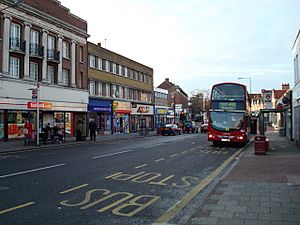 Sidcup High Street |
|
| Population | 15,400 |
| OS grid reference | TQ461718 |
| London borough | |
| Ceremonial county | Greater London |
| Region | |
| Country | England |
| Sovereign state | United Kingdom |
| Post town | SIDCUP |
| Postcode district | DA14, DA15 |
| Post town | LONDON |
| Postcode district | SE9 |
| Dialling code | 020 |
| Police | Metropolitan |
| Fire | London |
| Ambulance | London |
| EU Parliament | London |
| UK Parliament |
|
| London Assembly |
|
Sidcup is a lively area in south-east London, England. It is mostly located in the London Borough of Bexley. Sidcup is about 18.2 kilometres (11.3 miles) south-east of Charing Cross, a famous spot in central London. It shares borders with the London Boroughs of Bromley and Greenwich. Before 1965, when Greater London was created, Sidcup was part of Kent.
The name Sidcup likely comes from an old English word, Cetecopp. This word means "seat-shaped" or "flat-topped hill." The name was first written down in 1254. In 2021, the population of Sidcup was about 15,400 people.
Contents
Sidcup's Past: A Journey Through Time
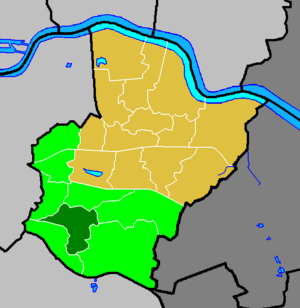
How Did Sidcup Begin?
Sidcup started as a very small village, or "hamlet," on the main road from Maidstone to London. Records show that a person named Thomas de Sedcopp owned land here in the 1450s. In the late 1700s, Sidcup was described as a "small street of houses." It even had a popular inn called the Black Horse pub.
Sidcup became its own local government area, called an Urban District, in Kent in 1908. It was first known as Foots Cray. But in 1921, the area was officially renamed Sidcup. Later, in 1934, Sidcup joined with Chislehurst to form a larger district. Then, in 1965, Sidcup became part of the London Borough of Bexley in Greater London. Chislehurst became part of the London Borough of Bromley.
Old Buildings with New Uses
Many old manor houses (large country homes) still stand in Sidcup today. They have been changed to serve new purposes:
- Frognal House was once the home of Thomas Townshend, 1st Viscount Sydney. Now, it is used for residential and nursing care.
- Lamorbey House is now part of Rose Bruford College.
- Sidcup Place is a popular bar and restaurant.
- The Hollies has been turned into homes.
What is Sidcup Like Today?
Sidcup is surrounded by other areas. To the north is Blackfen. To the east and northeast is Albany Park. Foots Cray is to the south-east, and Chislehurst is to the south and south-west. To the west is New Eltham, and Avery Hill is to the north-west.
Sidcup has a mix of homes. You can find large Victorian and Edwardian houses, along with many typical 1930s suburban homes. The area has lots of parks and green spaces. These remind us of the big estates and grand homes that used to be here.
The town is home to Queen Mary's Hospital, a large Leisure Centre, four colleges, and three secondary schools. Sidcup High Street is the main shopping and business area. There are also shops and businesses on Station Road nearby. In 2014, the High Street got a big makeover to make it even better.
Most of Sidcup is in the London Borough of Bexley. However, some northern parts are managed by the Royal Borough of Greenwich. These include areas like Southspring and Halfway Street.
Sidcup's Location
Sidcup is located:
- About 4.5 kilometres (2.8 miles) south-west of Bexleyheath.
- About 6.4 kilometres (4 miles) north-east of Bromley.
- About 5.3 kilometres (3.3 miles) north of Orpington.
- About 5.5 kilometres (3.4 miles) north-west of Swanley.
Who Lives in Sidcup?
In 2021, about 15,400 people lived in Sidcup. About 18.5% of residents are aged 65 or older. This is a little higher than the average for the whole London Borough of Bexley.
The 2021 census showed that about 18.1% of Sidcup's population were from non-white backgrounds. The largest group was Asian or Asian British, making up 7.0% of all residents. About 48.5% of people said they were Christian. "No religion" was the second largest group, at 38.8%.
Learning in Sidcup
Sidcup has many schools for different age groups.
Primary Schools
Some primary schools in Sidcup include:
- Birkbeck
- Burnt Oak Junior School
- Chatsworth
- Days Lane
- Holy Trinity Lamorbey
- Longlands
- Orchard School
- Our Lady of the Rosary
- Royal Park
- Sherwood Park
- St Peter Chanel
Secondary Schools
Secondary schools in Sidcup include:
- Chislehurst and Sidcup Grammar School
- Blackfen School for Girls
- Cleeve Park School
- Hurstmere School
- Kemnal Technology College
Colleges
Several colleges also have campuses in Sidcup:
- Bird College (for dance and musical theatre)
- Christ the King: St Mary's (RC) Sixth Form College
- Rose Bruford College (for drama and theatre)
Healthcare in Sidcup
Sidcup has a history of providing healthcare. Sidcup Cottage Hospital first opened in 1882. It later moved to a new building in 1890. This hospital closed in 1974, and the Barnard Medical Practice now stands on its site.
Queen Mary's Hospital opened in 1917. It started with 300 beds in wooden huts. Until 1925, it was a special military hospital for soldiers needing surgery after war injuries. Sir Harold Gillies, a famous surgeon, led this work. The original hospital closed in 1929 but reopened in 1930 as a general hospital. It was named after Queen Mary. A new building for the hospital opened in 1965. Since 2013, it has been managed by the Oxleas NHS Foundation Trust.
Sports and Fun in Sidcup
Sidcup offers several sports and leisure activities.
Football and Rugby
Sidcup has a local football club called Sporting Club Thamesmead F.C.. They play at the Sporting Club Thamesmead. On Sydney Road, you'll find the Sidcup Sports Club, which is home to local rugby and cricket teams.
Swimming and Gym
Sidcup also has a Leisure Centre on Hurst Road. It has two swimming pools and a gym for people to stay active.
Motorcycle Sports
The Sidcup and District Motor Cycle Club was started in 1928. This club owns a motorcycle sport venue called Canada Heights, located in Button Street, Swanley.
Culture and Community in Sidcup
Sidcup is known for its performing arts colleges: Rose Bruford College and Bird College. Both have trained many famous actors and performers. Sidcup also has its own Sidcup Symphony Orchestra, which plays music for the wider South East London area.
The town has seen efforts to raise awareness about important issues. For example, after the tragic death of young actor Rob Knox in 2008, his family started a campaign to end knife crime among young people. The Rob Knox Foundation organizes a film festival in Sidcup and nearby Bexleyheath. A special bench was also dedicated to Rob Knox at St John's Church in Sidcup in 2015.
Getting Around Sidcup
Trains
Sidcup railway station opened in October 1866. It is about 1.6 kilometres (1 mile) north of Sidcup town centre. The station offers train services by Southeastern. You can travel to London Charing Cross and to Gravesend.
Roads
Sidcup High Street is part of the A211 road. This road follows an old route that connected London, Maidstone, and Hythe. The A211 links two important roads in the area: Station Road and Main Road.
The A2 road, called East Rochester Way, also runs partly through Sidcup. It connects to Blackfen Road and provides routes to the Blackwall Tunnel and Kent.
Buses
Sidcup is served by many Transport for London bus routes. These include routes 51, 160, 229, 233, 269, 286, 321, 492, 625, 669, B14, R11, and SL3. These buses connect Sidcup to many nearby areas. You can travel to places like Bexleyheath, Bromley, Catford, Crayford, Chislehurst, Dartford, Eltham, Greenwich, Erith, Lewisham, New Cross, Orpington, Swanley, Thamesmead, Welling, and Woolwich.
Famous People from Sidcup
Many notable people have connections to Sidcup:
- F. Matthias Alexander (1869–1955), an Australian actor who created the Alexander technique, lived in Sidcup for 30 years.
- Harry Arter (1989–), a footballer for Bournemouth F.C. and the Republic of Ireland team, was born in Sidcup.
- Steve Backley (1969–), an Olympic silver medallist in javelin, was born in Sidcup.
- Sam Bailey (1977–), who won The X Factor, grew up in Sidcup.
- Angela Barnes (1976–), an actress and comedian, was born in Sidcup.
- Lake Bell (1979–), an American actress, lived in Sidcup while studying at Rose Bruford College.
- Doreen Bird (1928–2004), a dance teacher, lived in Sidcup and started Bird College.
- Quentin Blake (1932–), a famous illustrator and artist, was born in Sidcup.
- Denis Bond (1946–), a children's author, actor, and scriptwriter, lives in Sidcup.
- John Paul Jones (1946–), the bass guitarist for the legendary band Led Zeppelin, was born in Sidcup.
- Rob Knox (1989–2008), an actor who appeared in Harry Potter and the Half-Blood Prince, was tragically killed in Sidcup.
- Douglas Macmillan (1884–1969), who founded Macmillan Cancer Support, lived and ran his charity from Knoll Road in Sidcup for many years.
- Nevil Shute (1899–1960), a novelist and engineer, lived in Sidcup while working at Vickers.
- Ethel Smyth (1858–1944), a composer and suffragette (someone who fought for women's right to vote), was born in Sidcup.
Fictional Characters with Sidcup Connections
- In the play The Caretaker by Harold Pinter, a character named Davies often talks about his important papers being in Sidcup.
- Roderick Spode, a fictional politician and fashion designer in P. G. Wodehouse's Jeeves stories, was the 7th Earl of Sidcup.
See also
 In Spanish: Sidcup para niños
In Spanish: Sidcup para niños


